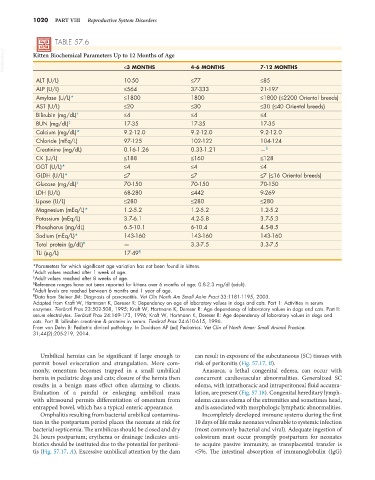Page 1048 - Small Animal Internal Medicine, 6th Edition
P. 1048
1020 PART VIII Reproductive System Disorders
TABLE 57.6
VetBooks.ir Kitten Biochemical Parameters Up to 12 Months of Age 4-6 MONTHS 7-12 MONTHS
<3 MONTHS
ALT (U/L) 10-50 ≤77 ≤85
ALP (U/L) ≤564 37-333 21-197
Amylase (U/L)* ≤1800 1800 ≤1800 (≤2200 Oriental breeds)
AST (U/L) ≤20 ≤30 ≤30 (≤40 Oriental breeds)
Bilirubin (mg/dL) † ≤4 ≤4 ≤4
BUN (mg/dL) ‡ 17-35 17-35 17-35
Calcium (mg/dL)* 9.2-12.0 9.2-12.0 9.2-12.0
Chloride (mEq/L) 97-125 102-122 104-124
Creatinine (mg/dL) 0.16-1.26 0.33-1.21 — §
CK (U/L) ≤188 ≤160 ≤128
GGT (U/L)* ≤4 ≤4 ≤4
GLDH (U/L)* ≤7 ≤7 ≤7 (≤16 Oriental breeds)
Glucose (mg/dL) ‡ 70-150 70-150 70-150
LDH (U/L) 68-280 ≤442 9-269
Lipase (U/L) ≤280 ≤280 ≤280
Magnesium (mEq/L)* 1.2-5.2 1.2-5.2 1.2-5.2
Potassium (mEq/L) 3.7-6.1 4.2-5.8 3.7-5.3
Phosphorus (mg/dL) 6.5-10.1 6-10.4 4.5-8.5
Sodium (mEq/L)* 143-160 143-160 143-160
Total protein (g/dL) # — 3.3-7.5 3.3-7.5
TLI (µg/L) 17-49 ¶
*Parameters for which significant age variation has not been found in kittens.
† Adult values reached after 1 week of age.
‡ Adult values reached after 8 weeks of age.
§ Reference ranges have not been reported for kittens over 6 months of age; 0.8-2.3 mg/dl (adult).
# Adult levels are reached between 6 months and 1 year of age.
¶ Data from Steiner JM: Diagnosis of pancreatitis. Vet Clin North Am Small Anim Pract 33:1181-1195, 2003.
Adapted from Kraft W, Hartmann K, Dereser R: Dependency on age of laboratory values in dogs and cats. Part 1: Activities in serum
enzymes. Tierärztl Prax 23:502-508, 1995; Kraft W, Hartmann K, Dereser R: Age dependency of laboratory values in dogs and cats. Part II:
serum electrolytes. Tierärztl Prax 24:169-173, 1996; Kraft W, Hartmann K, Dereser R: Age dependency of laboratory values in dogs and
cats. Part III: bilirubin creatinine & proteins in serum. Tierärztl Prax 24:610-615, 1996.
From von Dehn B: Pediatric clinical pathology. In Davidson AP (ed) Pediatrics. Vet Clin of North Amer: Small Animal Practice.
31;44(2):205-219, 2014.
Umbilical hernias can be significant if large enough to can result in exposure of the subcutaneous (SC) tissues with
permit bowel evisceration and strangulation. More com- risk of peritonitis (Fig. 57.17, B).
monly, omentum becomes trapped in a small umbilical Anasarca, a lethal congenital edema, can occur with
hernia in pediatric dogs and cats; closure of the hernia then concurrent cardiovascular abnormalities. Generalized SC
results in a benign mass effect often alarming to clients. edema, with intrathoracic and intraperitoneal fluid accumu-
Evaluation of a painful or enlarging umbilical mass lation, are present (Fig. 57.18). Congenital hereditary lymph-
with ultrasound permits differentiation of omentum from edema causes edema of the extremities and sometimes head,
entrapped bowel, which has a typical enteric appearance. and is associated with morphologic lymphatic abnormalities.
Omphalitis resulting from bacterial umbilical contamina- Incompletely developed immune systems during the first
tion in the postpartum period places the neonate at risk for 10 days of life make neonates vulnerable to systemic infection
bacterial septicemia. The umbilicus should be closed and dry (most commonly bacterial and viral). Adequate ingestion of
24 hours postpartum; erythema or drainage indicates anti- colostrum must occur promptly postpartum for neonates
biotics should be instituted due to the potential for peritoni- to acquire passive immunity, as transplacental transfer is
tis (Fig. 57.17, A). Excessive umbilical attention by the dam <5%. The intestinal absorption of immunoglobulin (IgG)

